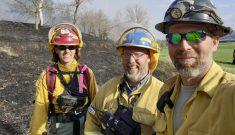Meagan Maitland was discing a field in fall of 2018 when her husband raced down the road to inform her of a nearby field fire.
It made her think about what would happen if she was presented with a similar situation — in a field by herself, in the middle of an emergency.
Maitland, who farms with her husband in Grenville County, wondered if she or someone else would be prepared and able to explain the location to emergency responders..
Emergency preparedness has always been important but as equipment becomes more complicated, farms become larger and the number of employees per operation grows, it is taking on added significance.
Read Also

Ontario’s agri-food sector sets sights on future with Agri-Food 2050 initiative
The first-ever Agri Food 2050, a one-day industry event dedicated to envisioning the future of food and farming in Ontario,…
Why it matters: As farms grow larger, there’s more need for accurate identification of all farm properties in case of emergency.
Agriculture and Agri-Food Canada suggests having supplies and a kit ready for when emergency responders need to be called.
The department recommends the following:
- A list of equipment, supplies and tools and where to find them.
- A list of people to contact in different situations.
- Ensuring that employees understand their roles in the event of different emergencies.
The emergency kit should include the following:
- The emergency plan.
- Records of the farm assets, such as a map of the farm, including the number of and type of livestock and equipment.
- Identifiers for the farm’s livestock if they need to evacuate the property.
“When first responders are on scene, it is important to have someone who is knowledgeable of exactly what operations the farm is involved in to be able to meet (the responders) on initial arrival and (identify) what hazards are on scene,” says Jason Gallagher, manager of Haldimand County Emergency Services and fire chief of the emergency services division.
The Maitlands created a list of all their farm addresses, laminated the list and made it accessible in every tractor that leaves the home property, the barn office, the house and the farm truck.
“It is also important there is an organized site. At farming accidents and fires a lot of apparatus will be responding and they will require room to set up and complete their tactics,” says Gallagher.
In 2017, the Farm 911 project was launched to encourage counties and municipalities across Ontario to promote the need for 911 signs at all farm properties, including those with no buildings.
This will benefit first responders in locating injured residents, says Gallagher. “With technology, cell phones are able to provide a close proximity when traced … but any additional resources are definitely a benefit.”
The emergency kit can help first responders, veterinarians or equipment operators to better handle the situation by having access to all information around the farming operation.
In terms of fire safety, farm operators should contact their local fire department for advice on making a fire safety plan.
The Haldimand County fire prevention division helps get farmers started.
“We don’t do it for them, but we can assist. We can do inspections, and if the inspector is on site and notices a violation of the code, he may write orders,” says Gallagher. “Agriculture is a bit different when it comes to fire code, which is why it is important to reach out the fire prevention.”
“I think every farm needs something in case there is some sort of emergency at any of the farms. With having kids on the farm, I am always wondering (what) we can do to implement more safety measures in the operation,” says Maitland.















